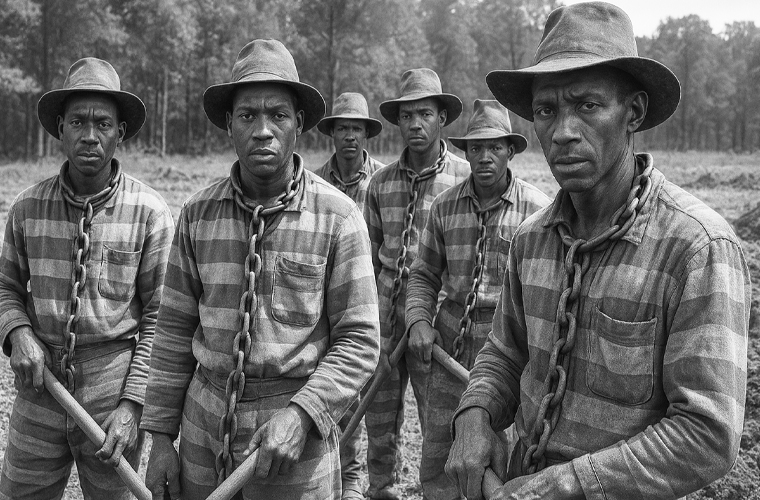Exploitation and Racial Injustice Post-Emancipation
Convict leasing was a system of forced labor that emerged in the Southern United States following the Civil War, effectively perpetuating slavery-like conditions under the guise of criminal punishment. This practice disproportionately targeted African Americans, who were ensnared by discriminatory laws and leased out to private companies for profit. Rooted in the loophole of the Thirteenth Amendment, which abolished slavery “except as a punishment for crime,” convict leasing allowed states to generate revenue while private entities exploited cheap labor in industries like mining, railroads, and agriculture. It has been described as “slavery by another name,” highlighting its role in maintaining racial and economic oppression in the post-Reconstruction era.
Origins and Historical Context
The convict leasing system originated in the mid-19th century but expanded dramatically after the abolition of slavery in 1865. Southern states, facing economic devastation from the war and the loss of enslaved labor, turned to leasing prisoners to private contractors as a means to rebuild infrastructure and boost revenues. Louisiana implemented the system as early as 1844, but it became widespread during Reconstruction (1865–1877). The Black Codes—laws enacted by Southern legislatures—criminalized everyday activities for Black people, such as vagrancy, loitering, or lacking proof of employment, leading to mass arrests and convictions. This selective enforcement resulted in African Americans comprising the vast majority of leased convicts, with states like Tennessee seeing Black incarceration rates rise from 33% in 1865 to 67% by 1879.
Northern states had earlier forms of convict labor, such as New York’s Auburn Prison contracted prisoners in 1823, but the Southern model was unique in fully transferring control to private lessees, often without state oversight. The system substituted for slavery, providing a steady supply of forced labor to industries that had previously relied on enslaved people.
How the System Operated
Under convict leasing, states auctioned off groups of prisoners to the highest-bidding private companies or individuals. These lessees assumed full responsibility for the convicts’ housing, food, and discipline, often in remote camps or mines. Prisoners worked in grueling conditions without pay, while states profited from leasing fees. Key industries included coal mining (e.g., by the Tennessee Coal, Iron and Railroad Company), railroad construction, phosphate mining in Florida, and lumber camps.
The practice was economically lucrative. In Alabama, convict leasing generated 10% of state revenues in 1883, rising to 73% by 1898—nearly four times the cost of prison administration. This financial incentive encouraged longer sentences and higher conviction rates for minor offenses, further entrenching the system’s racial bias. Even orphaned Black children and juveniles were sometimes “bought” as laborers for white planters, extending the exploitation beyond adults. States like Georgia (starting in 1868), Tennessee (until 1894), Texas (1883–1910), Alabama (1846–1928), and Florida (until 1919 at the state level, with counties continuing until 1923) were heavily involved. North Carolina did not formally prohibit it until 1933.
Impact on African Americans
African Americans bore the brunt of convict leasing, making up over 90% of leased prisoners in some states, such as Georgia, in 1908. Discriminatory sentencing and laws created a cycle of incarceration: Black individuals were arrested for petty crimes, convicted, and leased out, often for life-like terms. Prison populations exploded—Georgia’s increased tenfold from 1868 to 1908, and Alabama’s from 374 in 1869 to 2,453 in 1919.
Conditions were brutal, with high mortality rates from disease, overwork, and violence. Convicts endured torture, poor housing in shanties, and physical coercion, worse than antebellum slavery in some aspects, due to the lack of “investment” in workers’ long-term survival. The system suppressed wages for free workers and deepened racial separation, contributing to Jim Crow-era oppression. Artifacts like photographs of inmates at Angola Prison illustrate the ongoing legacy of this exploitation.
Resistance and Abolition
Resistance to convict leasing included armed uprisings, such as Tennessee’s Coal Creek War in 1891, where free miners attacked prison stockades, freeing convicts and pressuring the state to abolish the system by 1894. High-profile cases, like the 1921 flogging death of white convict Martin Tabert in Florida, generated national outrage and led to reforms, including Florida ending state leasing in 1923 after a Pulitzer Prize-winning exposé.
The system declined in the early 20th century due to economic shifts, industrialization, and political pressure, with Alabama as the last state to end it in 1928. However, President Franklin D. Roosevelt’s administration formally abolished federal convict leasing in 1941 via Circular No. 3591. County-level practices lingered into the 1940s, and forms of prison labor persist today, with the Thirteenth Amendment’s exception still allowing unpaid work for prisoners.
Legacy
Convict leasing left a profound legacy of racial injustice in America’s criminal justice system, contributing to mass incarceration disparities that continue today. Discoveries like the 2018 cemetery in Sugar Land, Texas, containing remains of 95 leased convicts, underscore the human cost. It served as a bridge between slavery and modern prison labor, reminding us of how legal loopholes can perpetuate exploitation. Advocacy, as seen in protests for figures like the Angola Three, highlights ongoing efforts to address these historical wrongs.

